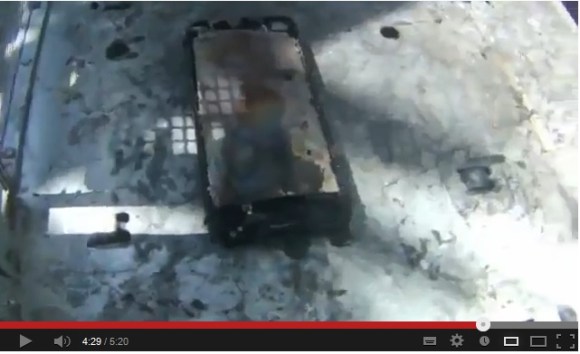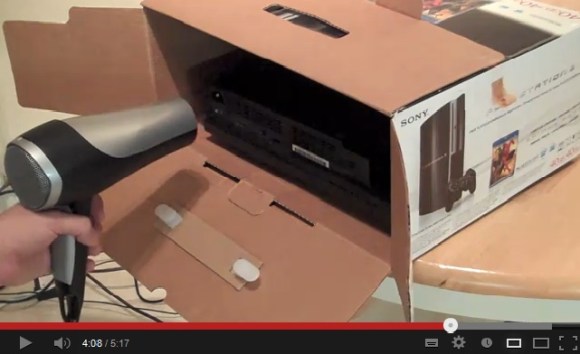
Sony’s recent publicly-announced warning not to put your gaming console in the microwave, has left most of the online community completely lost for words. If you happen to be the owner of a Sony gaming console, placing it in the microwave only to fry the hell of it is surely the last thing on your agenda. Nevertheless, it cannot be denied that such reports have recently been doing the rounds on the net. Frying your treasured gaming console obviously defies all forms of common sense and I’m sure most of you will be racking your brains as to whom and under what circumstances would do such a thing.
So just why would Sony issue such a bizarre warning? In short, Sony appears only to be going by the facts, or should we say the evidence that remains resident on the game console after being submitted for repair:
“Of the defective products received by Sony, we have detected on some rate occasions evident changes in the shape of the unit and even burn marks that can only be assumed to have been brought about by the use of an electrical appliance such as a hairdryer or microwave”.
Sony adds, “Heating up your game console leads not only to a defective unit but also creates the risk of a fire or even serious injury”.
Whilst there is much speculation and even theories out there as to why game users would resort to such an act, hard evidence is much lacking.
So just what are some of these theories?
Forget about sending your broken game console to Sony: if you have a hairdryer at hand, repair it yourself the D.I.Y way! – Or so the ‘hairdryer method’ would have you believe!
■ The ‘hairdryer method’
This problem has become much less prominent among the most recent batch of PlayStation3 consoles. However, when the console was first released in 2006, there were many reports of the unit’s power source suddenly failing. Such a defect, similar to the Xbox 360’s “ring of death”, unquestionably brought great misery to many gaming fans.
As a counter-measure, rumors quickly spread amongst die hard gamers that the cause of this defect had to do with the console’s inner components’ solder points peeling away. Without actually knowing whether this bared any foundation of truth or not, holding a hairdryer up to your console, putting it on full heat and waiting for the result, appears to have taken root as common practice for many. Again, there is no actual evidence- only net users speaking out- but from the reports alone, after trying this method, the console was restored to complete working order or at least worked for the short term.
When it comes to the ‘hairdryer method’, there are many net users willing to tell of their experiences. “Yeah, I’ve tried that myself”, is the typically reply from many. It would appear that amongst those in the know about repairing the PlayStation 3 ‘D.I.Y style’, this method poses itself as nothing new.
■Why are so many users resorting to such a method?
Behind this are two main reasons: One is the risk that sending your console in for repair, as is often the case with Sony, will entail a complete hardware exchange. Building up that score, or establishing that achievement doesn’t come from nowhere. All the hours of hard game play, along with the defective console disappear into the oblivion that is the Sony repair center. Even if the hairdryer method is only a temporary measre, there is still time to backup all that important data so that it can be transferred to another machine.
The second reason has to do with the actual cost of repair. Sony charges around 15,000 yen (about $175) for general repair of its PlayStation 3; admittedly a little on the steep side. Of course Sony does not recognize the ‘dryer method’ for a moment, and compounds this by adding that, of the consoles that ‘come back to life’, “it remains unclear as to whether or not this has any bearing on the solder points of the machine”.
■Theories regarding the use of the microwave
For the time being let’s put the ‘hairdryer method’ aside as we delve a little more into recent incidents involving the microwave! So why would anyone resort to putting their console in the microwave? Again this is mere speculation but some of the opinions taking weight are as follows:
“Maybe microwaving the PlayStation gets rid of the cracks in the solder points?”, is one speculation.
Another one is, “Perhaps the aim is to get a hardware exchange. Within the guarantee period, altering the hardware so as to make it look like a manufacturing defect could be one of the tricks being pulled here”.
One particular rumor that is unparalleled in terms of its undeniable absurdity is that which claims, “By microwaving your mobile phone you can charge your battery in an instant”.
In August of 2012, similar false rumors – that putting your iPhone in the microwave charges your phone in an instant- made their way around the net. There were believed to be taken from recent scientific research into the use of electromagnetic waves and the charging of batteries. Although the household microwave and the development of new battery charging technology both share the common ground of electromagnetic waves, the technology itself is completely different. It is absurd for anyone to believe that the two are in some way related, and yet it appears that some people genuinely believe such lies.
There have even been members of the public willing to forsake their new iPhone in the pursuit of the truth. One net user actually went ahead and zapped his iPhone! He placed the footage on YouTube. As you can imagine, the prospects of bringing your iPhone back to life after a frying in the microwave, are grim to say the least. It was reported that there was a distinct burning smell- needless to add that afterwards his phone wouldn’t even turn on. On the same post, under the comments section, another brave internet user reports of trying it out on his Nintendo DS. Of course, just how true this claim is remains unknown, however be warned whether it be a game console or a mobile phone, putting it in the microwave will only lead to its sudden death!
For those of you wondering what a fried iphone actually looks like, check out the videos below!
http://www.youtube.com/watch?v=RHSlBo_fcPY
Source: jcast.com


 Private booths are coming to Japan’s Shinkansen bullet trains even sooner than we’d thought【Video】
Private booths are coming to Japan’s Shinkansen bullet trains even sooner than we’d thought【Video】 Rakuten randomly offers 58 New Year’s osechi feasts in Japan, but did we get a star or a dud?
Rakuten randomly offers 58 New Year’s osechi feasts in Japan, but did we get a star or a dud? The oldest tunnel in Japan is believed to be haunted, and strange things happen when we go there
The oldest tunnel in Japan is believed to be haunted, and strange things happen when we go there Daiso unveils new official mascot, Daizo the elephant
Daiso unveils new official mascot, Daizo the elephant Coca-Cola Japan unveils new sakura design bottle for cherry blossom season 2019
Coca-Cola Japan unveils new sakura design bottle for cherry blossom season 2019 Private booths are coming to Japan’s Shinkansen bullet trains even sooner than we’d thought【Video】
Private booths are coming to Japan’s Shinkansen bullet trains even sooner than we’d thought【Video】 Rakuten randomly offers 58 New Year’s osechi feasts in Japan, but did we get a star or a dud?
Rakuten randomly offers 58 New Year’s osechi feasts in Japan, but did we get a star or a dud? The oldest tunnel in Japan is believed to be haunted, and strange things happen when we go there
The oldest tunnel in Japan is believed to be haunted, and strange things happen when we go there Daiso unveils new official mascot, Daizo the elephant
Daiso unveils new official mascot, Daizo the elephant Coca-Cola Japan unveils new sakura design bottle for cherry blossom season 2019
Coca-Cola Japan unveils new sakura design bottle for cherry blossom season 2019 Yokohama restaurant serves fried axolotl, along with giant isopod, camel, and crocodile
Yokohama restaurant serves fried axolotl, along with giant isopod, camel, and crocodile Cosplay costume room tour by Japan’s number-one cosplayer Enako is an eye-opener【Video】
Cosplay costume room tour by Japan’s number-one cosplayer Enako is an eye-opener【Video】 Four Shinto shrines to pray for love at in Japan to start the New Year
Four Shinto shrines to pray for love at in Japan to start the New Year Original Totoro plush toys from 80s and 90s re-issued for Studio Ghibli exhibition
Original Totoro plush toys from 80s and 90s re-issued for Studio Ghibli exhibition Dragon Quest Burgers and Slime drinks are coming to McDonald’s Japan【Video】
Dragon Quest Burgers and Slime drinks are coming to McDonald’s Japan【Video】 Starbucks Japan ready to get Year of the Horse started with adorable drinkware and plushies【Pics】
Starbucks Japan ready to get Year of the Horse started with adorable drinkware and plushies【Pics】 Japanese beef bowl chain Sukiya’s 2026 Smile Box lucky bag basically pays for itself
Japanese beef bowl chain Sukiya’s 2026 Smile Box lucky bag basically pays for itself Hayao Miyazaki says Happy New Year to Studio Ghibli fans with new art for Year of the Horse
Hayao Miyazaki says Happy New Year to Studio Ghibli fans with new art for Year of the Horse Cup Noodle tries an authentic Jiro-style ramen, but something’s not quite right
Cup Noodle tries an authentic Jiro-style ramen, but something’s not quite right The best Starbucks Japan Frappuccinos we want to drink again in 2026
The best Starbucks Japan Frappuccinos we want to drink again in 2026 We revisited Sweets Paradise after a decade to see if Japan’s dessert buffet still delivers
We revisited Sweets Paradise after a decade to see if Japan’s dessert buffet still delivers That time Seiji called JASRAC to ask why he didn’t get paid royalties for his song being on TV
That time Seiji called JASRAC to ask why he didn’t get paid royalties for his song being on TV We found possibly the quietest Japanese-style hotel in Tokyo’s bustling Shinjuku district
We found possibly the quietest Japanese-style hotel in Tokyo’s bustling Shinjuku district Pizza Hut Japan’s hot lucky bags are perfect for a New Year’s pizza party
Pizza Hut Japan’s hot lucky bags are perfect for a New Year’s pizza party Japan’s oldest largetooth sawfish in captivity back on display in Mie Prefecture
Japan’s oldest largetooth sawfish in captivity back on display in Mie Prefecture 7-Eleven Japan starts new temporary luggage storage service in over 300 branches
7-Eleven Japan starts new temporary luggage storage service in over 300 branches Disillusionment at Tsukiji’s tourist-target prices led us to a great ramen restaurant in Tokyo
Disillusionment at Tsukiji’s tourist-target prices led us to a great ramen restaurant in Tokyo Starbucks teams up with 166-year-old Kyoto doll maker for Year of the Horse decorations【Photos】
Starbucks teams up with 166-year-old Kyoto doll maker for Year of the Horse decorations【Photos】 Tokyo considering law requiring more trash cans following litter increase in heavily touristed area
Tokyo considering law requiring more trash cans following litter increase in heavily touristed area Tokyo’s Tsukiji sushi neighborhood asks tour groups to stay away for the rest of the month
Tokyo’s Tsukiji sushi neighborhood asks tour groups to stay away for the rest of the month Tokyo event lets you travel back in time, for free, to celebrate 100 years since Showa era start
Tokyo event lets you travel back in time, for free, to celebrate 100 years since Showa era start Japan may add Japanese language proficiency, lifestyle classes to permanent foreign resident requirements
Japan may add Japanese language proficiency, lifestyle classes to permanent foreign resident requirements Sanrio theme park in Japan announces plans to expand into a Sanrio resort
Sanrio theme park in Japan announces plans to expand into a Sanrio resort Stamina-destroying “Paralysis Noodles” are Tokyo’s newest over-the-top ramen innovation
Stamina-destroying “Paralysis Noodles” are Tokyo’s newest over-the-top ramen innovation Survey asks foreign tourists what bothered them in Japan, more than half gave same answer
Survey asks foreign tourists what bothered them in Japan, more than half gave same answer Japan’s human washing machines will go on sale to general public, demos to be held in Tokyo
Japan’s human washing machines will go on sale to general public, demos to be held in Tokyo Japan’s deadliest food claims more victims, but why do people keep eating it for New Year’s?
Japan’s deadliest food claims more victims, but why do people keep eating it for New Year’s? We deeply regret going into this tunnel on our walk in the mountains of Japan
We deeply regret going into this tunnel on our walk in the mountains of Japan Studio Ghibli releases Kodama forest spirits from Princess Mononoke to light up your home
Studio Ghibli releases Kodama forest spirits from Princess Mononoke to light up your home Major Japanese hotel chain says reservations via overseas booking sites may not be valid
Major Japanese hotel chain says reservations via overseas booking sites may not be valid Put sesame oil in your coffee? Japanese maker says it’s the best way to start your day【Taste test】
Put sesame oil in your coffee? Japanese maker says it’s the best way to start your day【Taste test】 No more using real katana for tourism activities, Japan’s National Police Agency says
No more using real katana for tourism activities, Japan’s National Police Agency says Starbucks Japan reveals new sakura drinkware collection, inspired by evening cherry blossoms
Starbucks Japan reveals new sakura drinkware collection, inspired by evening cherry blossoms Updated cherry blossom forecast shows extra-long sakura season for Japan this year
Updated cherry blossom forecast shows extra-long sakura season for Japan this year Yokohama restaurant serves fried axolotl, along with giant isopod, camel, and crocodile
Yokohama restaurant serves fried axolotl, along with giant isopod, camel, and crocodile Cosplay costume room tour by Japan’s number-one cosplayer Enako is an eye-opener【Video】
Cosplay costume room tour by Japan’s number-one cosplayer Enako is an eye-opener【Video】 Four Shinto shrines to pray for love at in Japan to start the New Year
Four Shinto shrines to pray for love at in Japan to start the New Year Original Totoro plush toys from 80s and 90s re-issued for Studio Ghibli exhibition
Original Totoro plush toys from 80s and 90s re-issued for Studio Ghibli exhibition Dragon Quest Burgers and Slime drinks are coming to McDonald’s Japan【Video】
Dragon Quest Burgers and Slime drinks are coming to McDonald’s Japan【Video】 Urusei Yatsura Cafe to open in four cities in Japan as part of celebration of Lum’s return【Pics】
Urusei Yatsura Cafe to open in four cities in Japan as part of celebration of Lum’s return【Pics】 Idol group AKB48 sells 2.5 million copies of new CD, bags full of them end up in trash days later
Idol group AKB48 sells 2.5 million copies of new CD, bags full of them end up in trash days later Abysmal viewer ratings for Pokémon anime series does not worry its broadcaster the slightest bit
Abysmal viewer ratings for Pokémon anime series does not worry its broadcaster the slightest bit Is the AKB48-style idol singer promotion system limiting Japanese music’s global appeal?
Is the AKB48-style idol singer promotion system limiting Japanese music’s global appeal?
Leave a Reply